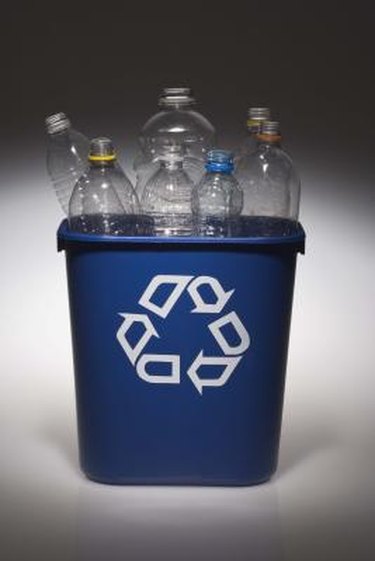
Plastics are the result of science. Plastics are compounds created from fossil fuels, and plastics have some amazing capabilities and properties. It is astounding that so many compounds can be made that have similar qualities without actually being the same. One way to tell various plastics apart is looking at the recycling symbol, a triangle of arrows, usually on the base of plastic items. Inside the triangle there is sometimes a number, and that number denotes the type of plastic the item is made of.
Not Microwave Safe: 3, 6, 7
Video of the Day
Although the number within the recycling symbol won't definitely determine if the plastic is necessarily recyclable, it does definitely specify what is not microwaveable. Avoid putting type 3 PVC, type 6 polystyrene and type 7 polycarbonate into a microwave oven. They are potentially carcinogenic and may leach Besphenol A, a potentially deadly toxin, into the food. This includes Styrofoam, type 6.
Video of the Day
Sometimes Safe: 1, 2, 4
Use caution with types 1 polyethylene terephthalate, type 2 high density polyethylene; and type 4 low density polyethylene. These types are microwave safe when reinforced with strengthening chemicals to prevent the plastic from melting in the microwave. These plastics are blended to create yogurt or margarine containers, which are definitely not safe for use in a microwave oven. Types 1, 2 and 4 are microwave safe because they are resilient to heat and to melting, but not because they are high-heat food safe.
Best Bet: 5
Type 5 polypropylene is most often labeled "microwave safe." This plastic is sturdy and heat resilient, and it stays clear even when exposed to tomato sauce. After being microwaved, the plastic feels cool. All plastics are derived from petroleum, however; so regardless of the type of plastic, high temperatures will cause chemicals to leach into food. When any plastic begins to pit or show signs of wear, the damage increases; so discontinue microwave and dishwasher use at that point.
Keep in Mind
In haste to sell more widgets, some companies that make plastics don't do all the research to ensure their items are totally safe. BPA, or Besphenol A, was linked to cancer-causing hormones in some products, notably baby bottles and sports bottles. The potentially deadly toxin was leaching into the food when the plastic got hot, mimicking estrogen and showing increased risk of breast cancer and lowered sperm counts in lab tests by the University of Pittsburgh Cancer Institute's Center for Environmental Ecology. It is unclear if the body is able to process the chemical into waste. According to Scientific American, the National Institute of Environmental Health Sciences found BPA impairing mouse fertility: "In animals, BPA can cause permanent effects after very short periods of exposure. It doesn't have to remain in the body to have an effect."
Better Safe Than Sorry
While the chemicals released by heating plastics might not do much noticeable harm today, glass and ceramic work equally well in a microwave oven and are always safe. Consider some CorningWare or Pyrex the next time you want to nuke your burrito.